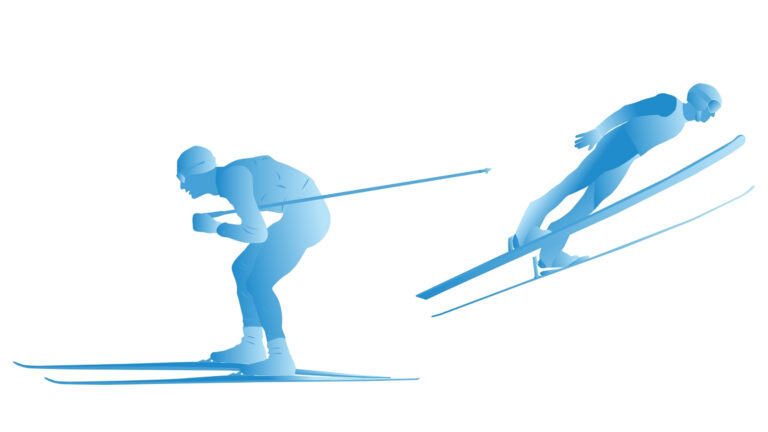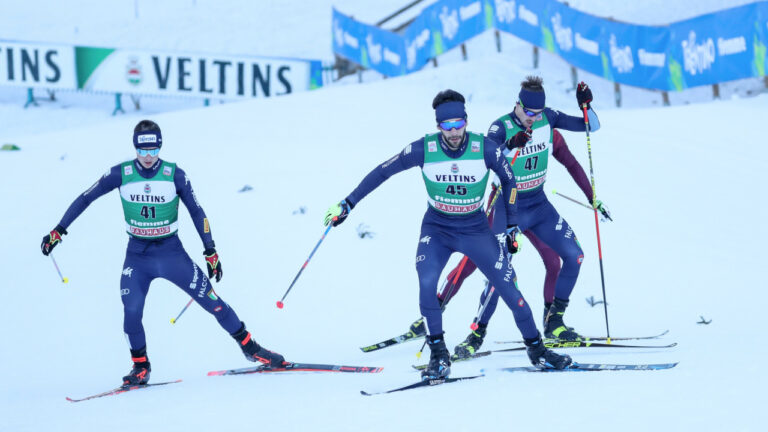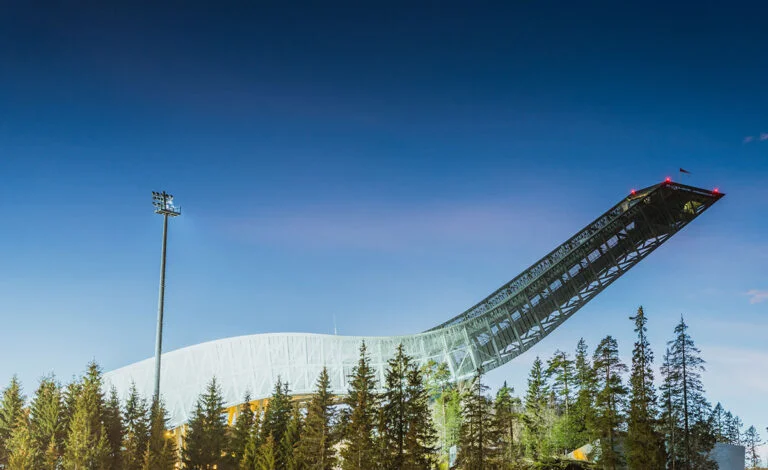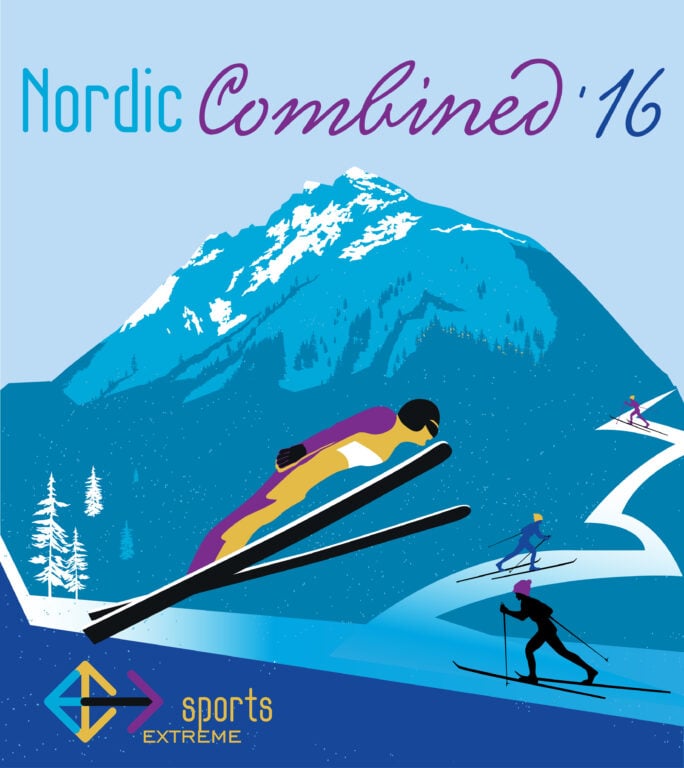Nordic Combined is a competitive winter sport that combines cross-country skiing and ski-jumping. Find out all you need to know about this challenging discipline.
When you think of competitive skiing, you probably think of Alpine or downhill skiing where you strap two skis tightly to your feet and get from the top to the bottom of a mountain as quickly as possible. But the Norse people like to do things a little differently.

Nordic Combined brings two very different disciplines of skiing–cross-country skiing and ski jumping–together into one exciting and daring endurance event.
Cross-country skiing
The word ski comes from the Old Norse word skíð meaning stick of wood. Skiing was originally used as a means of transportation in snowy areas. The same concept developed independently in a number of areas around the world.
There’s evidence of skiing in Scandinavia going back at least 5,000 years so it’s widely considered to be the first place where it developed.
The practice started being used for recreation and sport in the 1800s. Unlike Alpine skiing, where skis are tightly connected to the boots at the front and the back, cross-country skiing only connects the boots at the front. This allows the skier to propel the skis forward more easily.
There are two main styles of cross-country skiing: Classic and Skating. In classic style, the skis are parallel and this is mostly used on prepared pistes with two well-worn tracks or on fresh snow. With the skating style, the skis are used at an angle and the motion is similar to skating.
As early as 1767, a Danish-Norwegian general codified four disciplines of cross-country skiing for military competitions. One of these was ‘long racing', in which skiers wearing full military kit would race for 15 minutes over flat ground.

The sport developed further over the years and competitions were held in Norway and, eventually, other countries. It was contested at the first Winter Olympics in Chamonix, France, in 1924.
Ski jumping
Possibly the most terrifying form of skiing imaginable, ski jumping involves skiing straight down a long, steep, curved ramp before launching into the air and landing as far down the hill as possible.
The recorded origins date back to 1808 when Olaf Rye recorded a jump of 9.5m – not much by today’s standards but still impressive. The first competition with prizes was held in Høydalsmo in 1866. This was won by Sondre Norheim, who is considered to be the ‘father of modern ski jumping.'
Unlike most jumping events, it’s not simply the furthest distance that wins in ski jumping. Distance counts towards the points total but style points are decided by judges and added on. This means that the technique used is also important.
Distance is measured relative to a K-point, set at 90 or 120m from the takeoff point. Competitors are awarded a set number of base points (usually 60) for reaching the line, with extra points per metre over, and points deducted if they fall short.
Read more: Fun Facts About Skiing
The five judges award up to 20 style points each based on ski steadiness in flight, body position, balance and landing. Since 2009, gate and wind factors have been added.
Because aerodynamics play an important part in distances, if the wind changes direction scores can be adjusted to take account. Likewise, gate position is sometimes moved to make sure skiers can reach a proper take-off speed before the end of the ramp.

Like the other Nordic discipline of cross-country, ski jumping featured in the first Winter Olympics in 1924 and has been contested ever since. This was also when the Olympics was introduced to the more arduous sport of Nordic Combined.
Combining the Nordic disciplines
In competitive skiing, most participants choose and stick to a single style, be it downhill, jumping, cross-country, etc. Each style is very different and the skills involved are unique to their section.
Combining the two, rather like a triathlon combines swimming, running and cycling, means that those taking part need to be proficient in both the endurance of cross-country and the daredevil adrenaline rush of ski jumping.
The first major competition took place at the Holmenkollen ski jump in Oslo in 1892. It quickly proved popular, and regular competitions continued. In the 1920s, there was even a Royal connection as future King Olav V, then Prince Olav, competed in the Holmenkollen competition.
Along with its two constituents, Nordic Combined featured at the first Winter Olympics in 1924.
The sport originally started with cross-country, followed by ski jumping. This was reversed in the 1950s when leads in the cross-country were becoming impossible to overcome in the jumping section.
Gunder Gundersen
The Gunderson method that’s in use in most modern competitions was eventually established in the 1980s, by Gunder Gundersen. In this, the winner in the ski jump starts the cross-country section first, followed at intervals based on placement.
Each point in the ski jump is worth a time penalty (4 seconds in the individual race, since 2008). The winner, then, is simply the first person to cross the finish line.
Proving that sport is universal, the Gundersen Method has since been applied to other multi-sport events including the Modern Pentathlon where the start of the cross-country race is staggered based on points accrued in the other disciplines.
Nordic Combined competitions
Like all skiing competitions, Nordic Combined is regulated and overseen globally by the International Ski and Snowboard Federation (FIS).
The three main international competitions for Nordic Combined are the Winter Olympics every four years, the FIS Nordic World Ski Championships every two years and the FIS Nordic Combined World Cup every year.

It can be quite confusing at first, as the World Cup isn’t a single competition but a series of meetings over a whole ski season. It bears a lot of similarities to the Tour de France cycling competition and, in fact, the current leader is awarded a Yellow Bib to wear. The winner isn’t from a single event but over the course of many.
The World Cup currently consists of four types of events. Firstly, the Individual Gundersen with a single ski jump in the morning, followed by a 10km cross-country race, with starting times decided by the points in ski jumping. This makes up the majority of World Cup events.
Occasionally Mass Start events, where the cross-country event takes place first and skiers start together in one big group. Their result provides a points advantage or disadvantage in the ski jump, as in the original days of the sport.
The Nordic Combined Triple is arguably the most gruelling. Over three days, with competition each day. On day one there’s the Prologue – a single jump and a 10km ski. On the second day, the Individual Gundersen, the best 50 from day one compete in a single jump and a 15km ski.
On the third day, the Final Individual Gundersen, the best 30 go forward to compete in two jumps and a 20km. This is a winner-takes-all event, earning extra points towards the skier’s total as well as prize money just for the event.
Read more: The History of Skiing in Norway
The two remaining competitions are for teams. The Team Event involves a team of four. Results from their four ski jumps are combined to give their position. This is then followed by a 5km ski-relay. The Team Sprint is for two skiers. Their ski jump scores are combined again and used to determine their position in the sprint ski. Each of the pair skis 7.5km for a total of 15km, but in alternating laps of 1.5km.
The 2022-23 World Cup started in Ruka, Finland, with the Ruka Tour, in November 2022 and made its way through Norway, Austria, Estonia and Germany (the French leg had to be cancelled due to poor conditions) before finishing in Lahti, Finland, in March 2023.
The Triple took place in Seefeld, Austria, the Team Event took place at the World Championships in Slovenia and was not included in the World Cup reckoning. The Team Sprint was included, and that took place in Lahti, along with the final Individual Gundersen.
World Cup results
The 2022-23 World Cup was won overall by Johannes Lamparter of Austria with 1367 points. In second was Jens Lurås Oftebro of Norway followed by Julian Schmid of Germany. The reigning champion of 4 years, Norway’s Jarl Magnus Riiber came in fourth place.
The trophy for Best Ski Jumper went to Japan’s Ryōta Yamamoto, perhaps unsurprisingly as he has achieved the second longest ski jump in history! The trophy for best skier went to Norway Jens Lurås Oftebro.
The Nations Cup, awarded to the country with the most points overall, was won by Germany with 4295, ahead of Norway with 4168 and Austria with 4053. Fourth placed France only managed 1393, showing how dominant Germany, Norway and Austria are in the competition.
As for total medals, that was dominated by Norway with 22 out of a possible 34 Gold plus 12 Silver and 7 Bronze. Their 41 medals didn’t quite double second-place Austria’s 22 but it was close! Germany managed 25 (but fewer Gold than Austria) to finish third. That’s 88 out of a possible 102 shared by just three countries.
Women in Nordic Combined
Opening up Nordic Combined to women has been a very recent and slow process. 2020-21 was the first season with a women’s World Cup in the sport. There was hope that it might be included in the Winter Olympics in Beijing 2022 but the IOC refused saying the sport “needed time to develop a competitive scene”.
Apparently, however, they don’t feel that four years is long enough. They have already ruled that Nordic Combined will once again be the only Men’s only sport at the Winter Olympics in 2026.
Part of the problem is that, as they say, the sport doesn’t have enough competitors to make it much of a spectacle. So far, one competitor, Norway’s Gyda Westvold Hansen, has basically dominated all of the women’s world cup events. She won every event at the 2022-23 Women’s World Cup with 1000 points, almost double her nearest rival’s 589.
Unfortunately, this has led the IOC to look at the men’s sport too. Even though it has been fiercely contested in every Winter Olympics to date, its future is far from assured. The inclusion of Nordic Combined in the 2030 Winter Olympics may be in doubt.
The IOC feels that the audiences are too low and there’s little public interest. Further, the domination by just three nations and the relative lack of nations even sending competitors makes it not a true global sport.
Hopefully the IOC won’t make any hasty decisions and we will see this excellent Nordic sport continue to survive. However, much like football, the Olympics is far from the pinnacle of the sport. So perhaps it’s not a great problem.
After all, we’ll still have the FIS World Cup to watch and that’s where the real action happens.
Have you ever watched Nordic Combined? Perhaps you've even given it a try? Let us know in the comments below.

